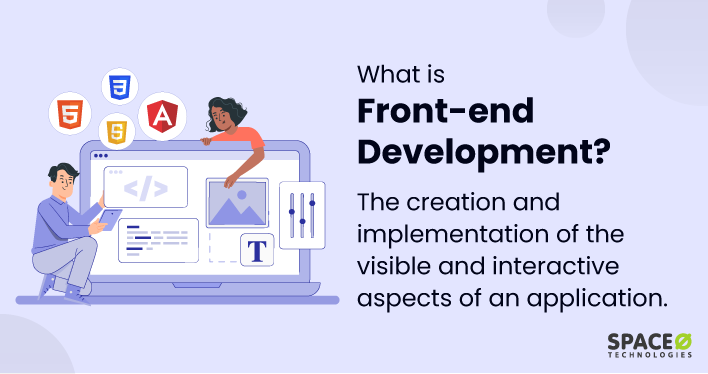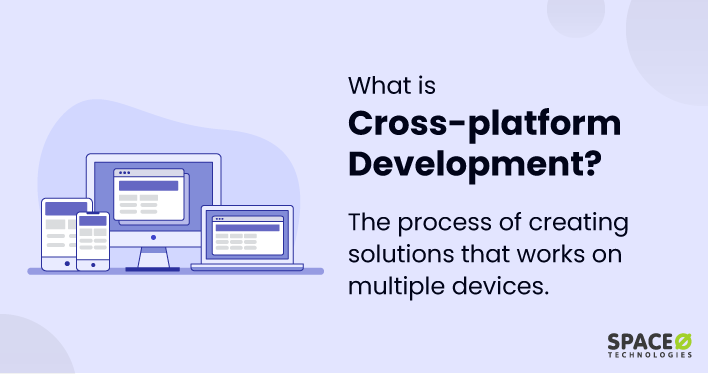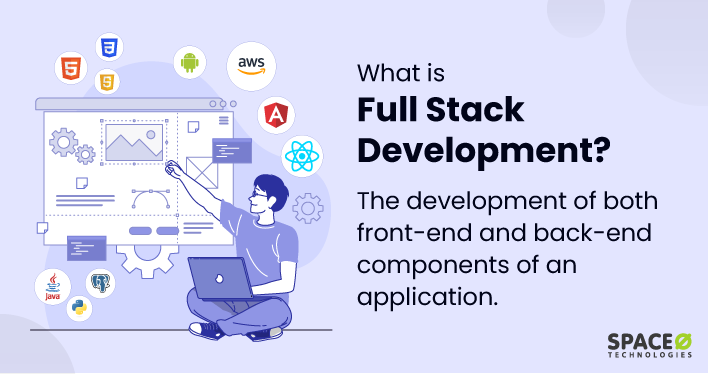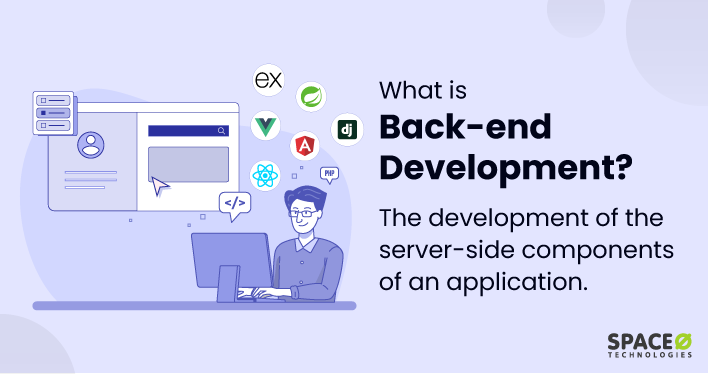Table of Contents
What is Front-end Development?
Front-end development is the process of creating and implementing the visual and interactive elements of websites and web applications. Front-end development involves using web technologies like HTML, CSS, and JavaScript to build the user interface and user experience of a website.
For example, a front-end developer might create the layout, colors, and typography of a website, as well as interactive features like dropdown menus or sliders for web development.
While the front-end development is one part of the whole process, developing a fully functional web application involves more comprehensive steps. If you want to develop the front end of the web app, learning about the web app development process can be helpful to you. Following this simple 10-step process of developing a web application will help you to develop a front-end web app solution hassle-free.
Now, let’s understand which technologies are used in front-end development
Technologies Used in Front-end Development
HTML (Hypertext Markup Language), CSS (Cascading Style Sheets), and JavaScript are the core programming languages used in front-end development.
In addition to these core technologies, front-end developers use a web application framework to streamline the development process. If you want to know in detail about web application framework and its advantages, read this post on what is a web application framework.
Here’s a table of front-end web development technology list with descriptions.
| Technology | Description |
|---|---|
| Hypertext Markup Language | The core language used to structure and format content on the web |
| Cascading Style Sheets | Used for styling and visually laying out web pages |
| JavaScript | Used to add interactivity and dynamic behavior to web pages |
| TypeScript | A superset of JavaScript that adds optional static typing and other features to JavaScript code |
| jQuery | A JavaScript library that simplifies working with the Document Object Model (DOM) |
| React | A popular JavaScript library for building user interfaces |
| Vue.js | A progressive JavaScript framework for building user interfaces |
| Angular | A TypeScript-based framework for building web applications |
| Ember.js | A JavaScript framework for building scalable web applications |
| Backbone.js | A lightweight JavaScript framework for building single-page applications |
| Bootstrap | A front-end framework for building responsive, mobile-first web pages |
By keeping up-to-date with the latest front-end development technologies, tools, and programming languages, developers can create modern and engaging web experiences for users. While the front-end focuses on the user interface, it’s only one part of the overall web development process. The other important component is backend development, which handles the server-side operations and ensures everything on the front-end functions as it should. If you’re curious about this, you can learn more from our detailed explanation of what is backend development.
Why is Front-end Development Important?
Front-end development offers numerous benefits for building modern and engaging web experiences. Let’s understand 4 core points on how front-end development is helpful.
Creates a Positive User Experience
The visual and interactive design elements of a website greatly impact a user’s perception of a website or web application. Front-end developers work closely with designers and UX specialists to ensure that the graphical user interface (GUI) and user experience of a website or web application are intuitive, engaging, and easy to use.
Provides Cross-platform Compatibility
Front-end developers must ensure that their code works across different devices such as desktops, tablets, and mobile phones with varying screen sizes and web browsers. By making sure that a website or web application looks and functions correctly across all platforms and screen sizes, front-end developers can improve the user experience and increase engagement.
Streamlines the Development Process
Front-end development technologies like HTML, CSS, and JavaScript can be used to create sophisticated user interfaces and user experiences in an efficient manner. Frameworks and libraries like React, Angular, and Vue.js can help streamline the development process even further.
Improves Website Performance
Front-end development provides a user-friendly experience by optimizing images, reducing page load times, and using modern web technologies like responsive design and lazy loading. By making a website or web app faster and more efficient, front-end developers can improve the user experience and increase engagement
Following best practices for front-end development and testing for cross-browser compatibility can ensure that a website or web application is accessible to all users, regardless of their device or disability. Now, let’s understand the best practices.
Best Practices for Front-end Development
Here are some of the best practices used for front-end development.
- Use semantic HTML: Semantic HTML helps search engines and screen readers better understand the content of a web page, improving accessibility and SEO. Use HTML tags that are appropriate for the content they contain, and avoid using non-semantic tags (e.g.or ) for things that have semantic meaning.
- Optimize images: Large image files can slow down page load times, so it’s important to optimize images for the web by compressing them and using the right file type. Use tools like Photoshop or online compression tools to reduce the size of images without compromising quality.
- Write modular CSS: Modular CSS, also known as component-based CSS, makes it easier to maintain and update CSS code by breaking it up into reusable, independent components. Use naming conventions and file organization to help keep code organized and maintainable.
- Use a version control system: Version control systems like Git can help manage changes to code over time and make it easier to collaborate with other developers. Use version control systems to keep track of changes to your code and collaborate with other developers.
- Write maintainable code: Writing maintainable code, including clear and concise comments, helps make it easier for other developers to understand and update code as needed. Use naming conventions and clear, descriptive comments to help make your code more maintainable.
Front-end development is a crucial aspect of building modern and engaging web experiences. By using technologies like HTML, CSS, and JavaScript, front-end developers create visually appealing and user-friendly interfaces that provide a positive user experience across multiple platforms and devices. Following best practices like using semantic HTML, optimizing images, and writing maintainable code can help front-end developers create efficient and accessible web applications.






